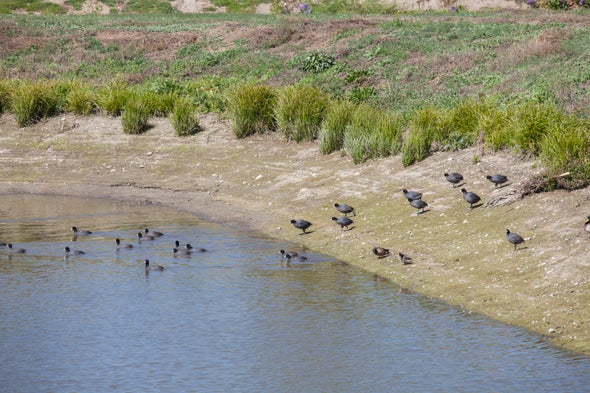

A desilting pond helps slow down water, allowing sediment to settle out before water is directed towards the infiltration basins in the San Gabriel Spreading Grounds in Los Angeles County. Credit: Citizen of the Planet/Universal Images Group via Getty Images
Pajaro Valley on the coast of central California has little surface water, so its farmers depend on extracting groundwater to grow leafy greens and berries for the global market. But as in many places around the world, these farmers have been pumping the water out faster than nature can replenish it. In different places, groundwater decline can cause various impacts: it can make land sink, streams, wetlands, and wells dry up and seawater creep inland under the ground. And because most pumped groundwater irrigates crops, major declines in availability could lead to a global food crisis.
In some places, water managers actively refill groundwater to ameliorate this tragedy of the commons. One method of doing so is to divert stormwater runoff into scooped basins that have been built over porous ground into which the water quickly sinks. But such efforts have been relatively small-scale and centralized, making them fall short of the current challenge. Depleted aquifers in California’s Central Valley alone have lots of empty space: three times the full capacity of the state’s more than 1,400 aboveground reservoirs. Yet California squandered much of the bounty from its recent unusually wet winter, as levees, channelized rivers and paved cities funneled much of the runoff into the ocean rather than capturing it. What’s needed is a distributed solution, says Graham Fogg, a University of California, Davis, professor emeritus of hydrogeology: many small projects scattered across the landscape that slow water, allowing it to infiltrate underground for storage. This would re-create nature’s method for refilling groundwater, which human development has largely eradicated.
An initiative in Pajaro Valley has been working to show how to make this vision a reality for more than a decade. Called recharge net metering (ReNeM), the idea is similar in some ways to rooftop solar net metering, which compensates homeowners for […]
Full article: www.scientificamerican.com
Clean water is essential for life, yet millions of Americans unknowingly consume contaminants through their…
Human brains contain higher concentrations of microplastics than other organs, according to a new study, and the…
From the Office of the Governor: In anticipation of a multi-day, significant atmospheric river in Northern California,…
From Governor Newsom: Scientists, water managers, state leaders, and experts throughout the state are calling…
Photo: A harmful algal bloom in Milford Lake, Kansas, made the water appear bright green.…
An expanded plastic foam coffee cup is at a donut shop in Monterey Park, California.…